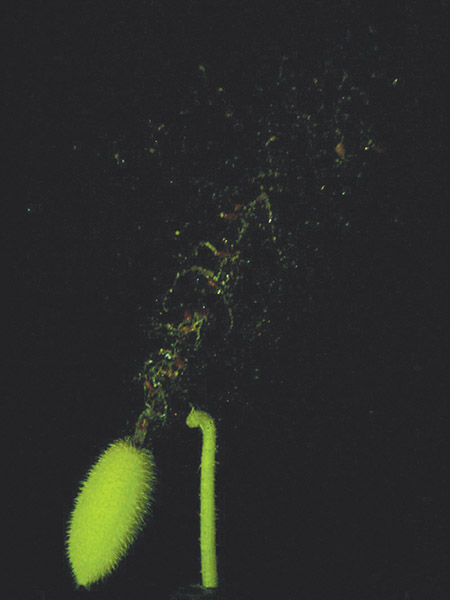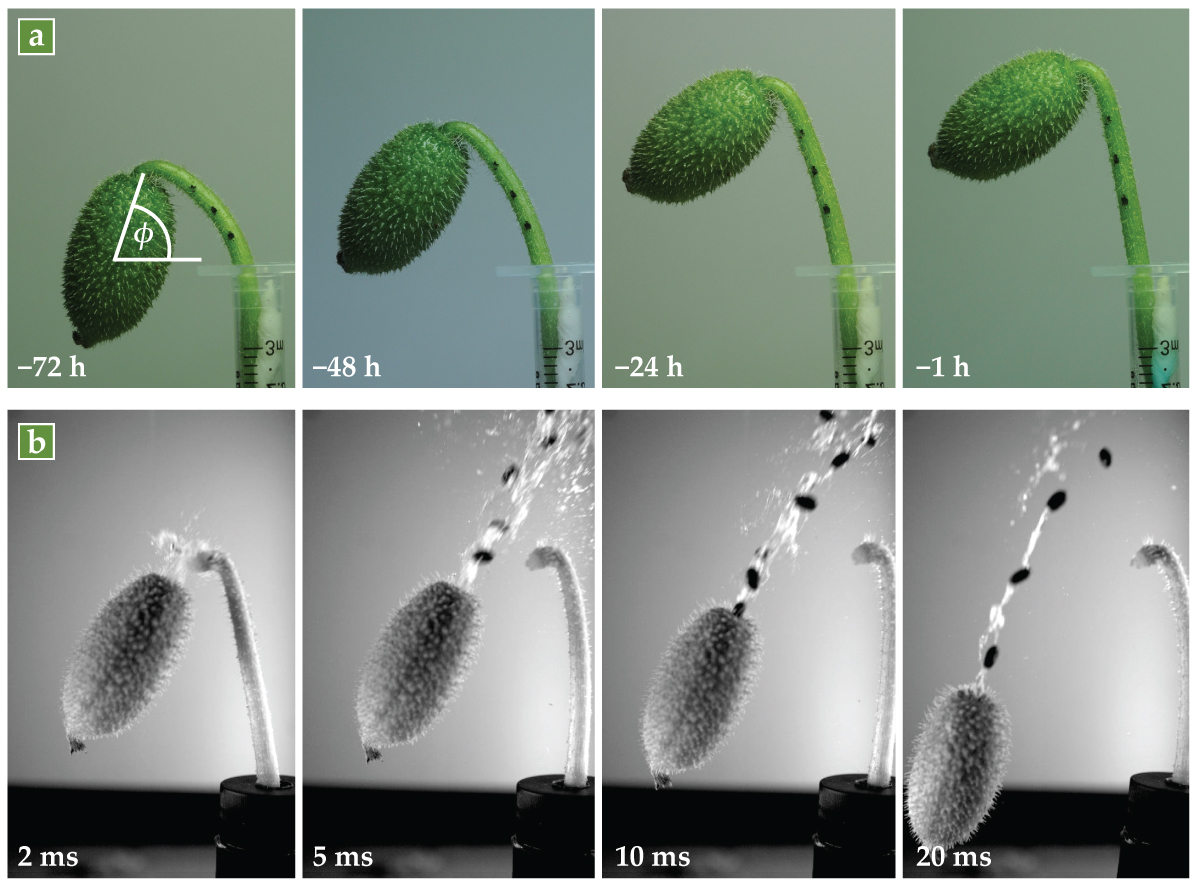Squirting cucumber seeds go ballistic
DOI: 10.1063/pt.utnw.jcqn

A still from high-speed video shows the moment a squirting cucumber fruit detaches from its stem and ejects a stream of fluid and seeds that can travel as far as 10 m, at speeds of up to 20 m/s. (Image from Dominic Vella.)

When you think of plants, you don’t usually think of fast-moving objects. But some flora have evolved seed-dispersal methods that don’t rely on the typical trick of hitching a ride via wind, water, or fauna. Rather, they convert stored pressure or elastic energy into kinetic energy to fling their seeds out into the world. The squirting cucumber is among the fastest of those seed-spitting plants. When ripe, the cucumber fruit falls from its stem and explosively launches a stream of fluid and seeds from the hole where it had been attached. Now, Finn Box and a set of colleagues from the University of Manchester and the University of Oxford, both in the UK, have unveiled details of how the cucumber achieves that feat.
Squirting cucumber seeds can travel as far as 10 m from their host plant and move at speeds of up to 72 km/h. Though it’s a member of the gourd family, which contains many popular edible plants, the squirting cucumber fruit is slightly poisonous and not eaten by any animals. The plants are commonly found in arid regions around the Mediterranean Sea and were written about as early as the first century CE, when they were described by Pliny the Elder, a Roman naturalist, author, and military commander.
When Box and colleagues started monitoring the plants in the days before seed dispersal, they expected to observe a buildup of pressure inside the fruit. But that’s not what they saw at all. “The pressure wasn’t building hugely, so it must have already been established weeks prior to launch,” says Box. The researchers actually observed a slight contraction of the fruit and a corresponding expansion of the stem, as if the fruit were transferring fluid to it. As the stem became more rigid over the course of several days, the fruit rotated from a near-vertical hanging position to a 45° angle, which created an optimal trajectory for the ejected seeds, as shown in the figure below.
Each cucumber fruit contains about 50 seeds, which are pushed out of the fruit in a matter of milliseconds. The first seeds fly out the fastest. A recoil of the stem imparts a rotation to the fruit, so that it spins toward a vertical orientation. That rotation, combined with the slowing speed of the ejected seeds, leads to an even dispersal of the seeds over a wide area. The research team used numerical models to simulate the effects of changing the fluid pressure in the stem or fruit and found that the squirting cucumber already has the optimal parameters. A higher pressure in the fruit than the observed 170 000 Pa drop, for example, caused more rotation that meant some seeds were launched straight up in the air and landed nearby.

Seed ejection. (a) In the days before seed ejection, fluid pressure increases in the stem of the squirting cucumber; the pressure changes the orientation ϕ of the fruit and maximizes the distance traveled by the seeds. (b) Once the fruit breaks from the stem, it ejects all its seeds in a few hundredths of a second. (Image adapted from F. Box et al., Proc. Natl. Acad. Sci. USA 121, e2410420121, 2024.

The squirting cucumber has already inspired designs for targeted drug-delivery systems that use hydrogel capsules, and Box hopes that unveiling the details of how it operates will yield more bioinspired engineering designs. For the next growing season, he’d like to observe the plants for several weeks, not just days, before seed dispersal. He hopes to capture the process of fluid-pressure buildup that was unexpectedly missed in the first round of observations. The squirting cucumbers “really blew our minds,” says Box. (F. Box et al., Proc. Natl. Acad. Sci. USA 121, e2410420121, 2024
This article was originally published online on 6 December 2024.

